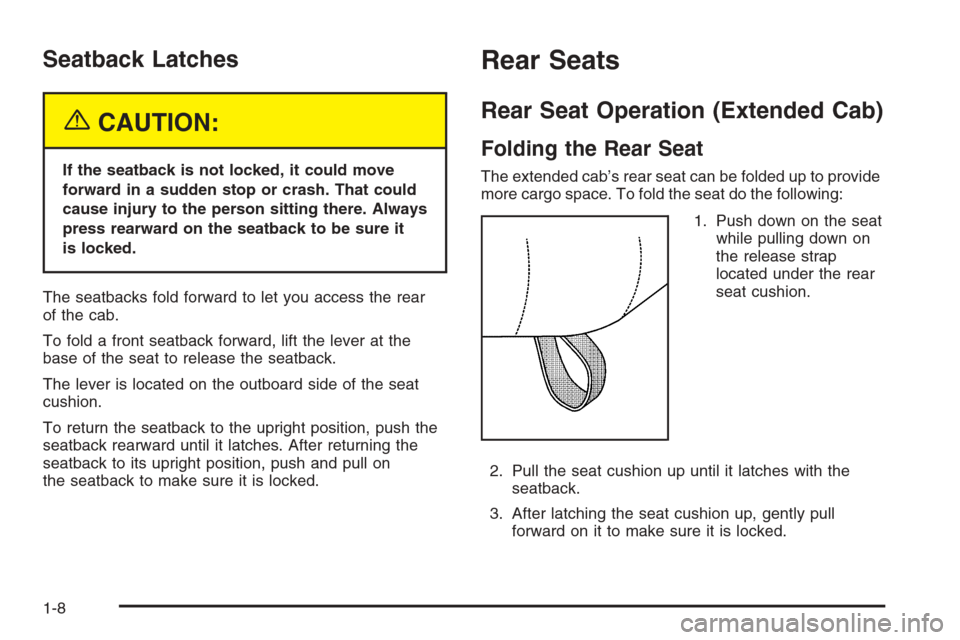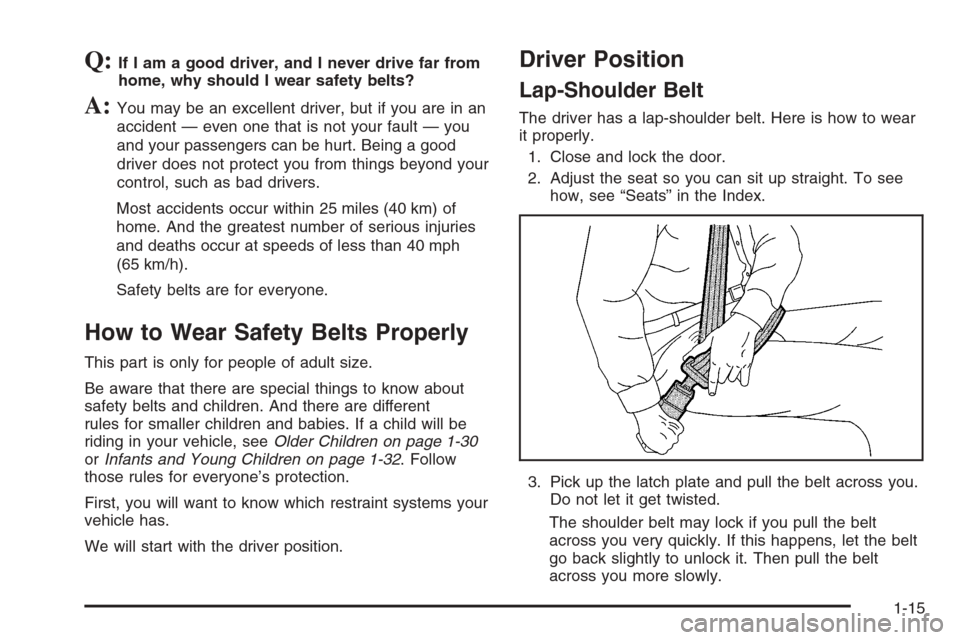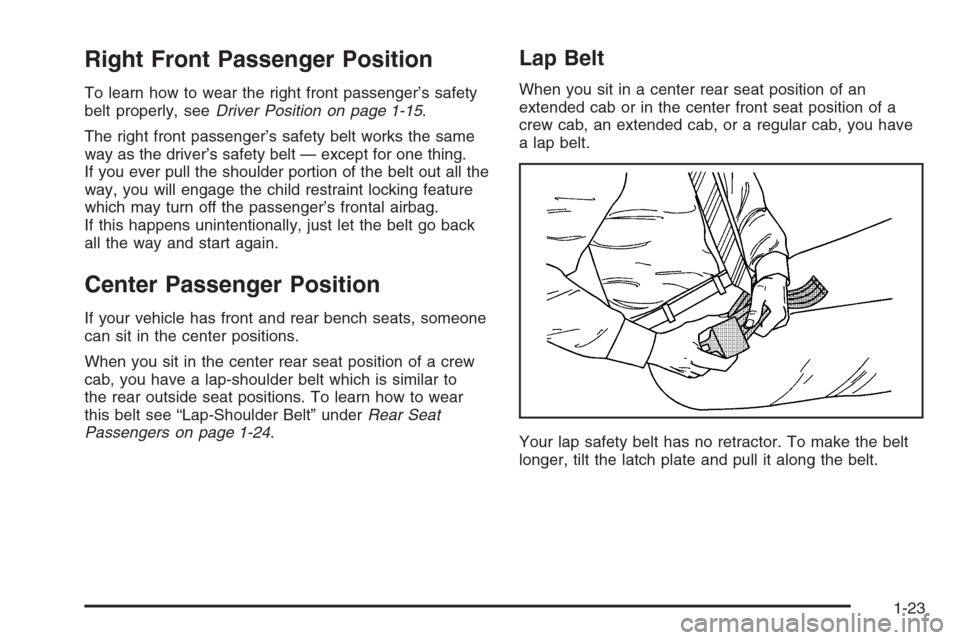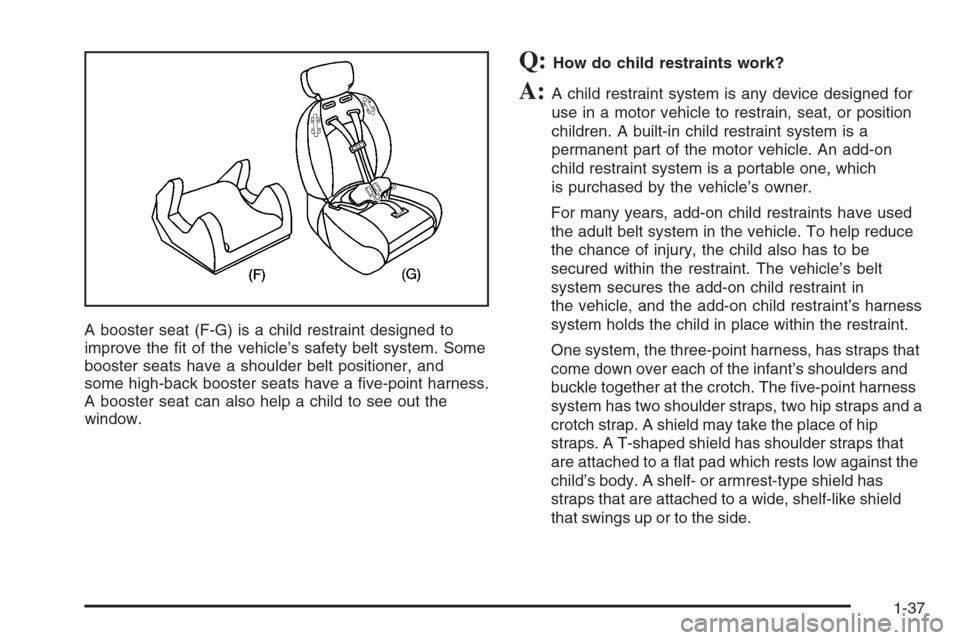Page 14 of 580

Seatback Latches
{CAUTION:
If the seatback is not locked, it could move
forward in a sudden stop or crash. That could
cause injury to the person sitting there. Always
press rearward on the seatback to be sure it
is locked.
The seatbacks fold forward to let you access the rear
of the cab.
To fold a front seatback forward, lift the lever at the
base of the seat to release the seatback.
The lever is located on the outboard side of the seat
cushion.
To return the seatback to the upright position, push the
seatback rearward until it latches. After returning the
seatback to its upright position, push and pull on
the seatback to make sure it is locked.
Rear Seats
Rear Seat Operation (Extended Cab)
Folding the Rear Seat
The extended cab’s rear seat can be folded up to provide
more cargo space. To fold the seat do the following:
1. Push down on the seat
while pulling down on
the release strap
located under the rear
seat cushion.
2. Pull the seat cushion up until it latches with the
seatback.
3. After latching the seat cushion up, gently pull
forward on it to make sure it is locked.
1-8
Page 16 of 580

Safety Belts
Safety Belts: They Are for Everyone
This part of the manual tells you how to use safety
belts properly. It also tells you some things you should
not do with safety belts.
{CAUTION:
Do not let anyone ride where he or she cannot
wear a safety belt properly. If you are in a
crash and you are not wearing a safety belt,
your injuries can be much worse. You can hit
things inside the vehicle or be ejected from it.
You can be seriously injured or killed. In the
same crash, you might not be, if you are
buckled up. Always fasten your safety belt,
and check that your passengers’ belts are
fastened properly too.
{CAUTION:
It is extremely dangerous to ride in a cargo
area, inside or outside of a vehicle. In a
collision, people riding in these areas are more
likely to be seriously injured or killed. Do not
allow people to ride in any area of your vehicle
that is not equipped with seats and safety
belts. Be sure everyone in your vehicle is in a
seat and using a safety belt properly.
Your vehicle has a light
that comes on as a
reminder to buckle up.
SeeSafety Belt Reminder
Light on page 3-33.
1-10
Page 21 of 580

Q:If I am a good driver, and I never drive far from
home, why should I wear safety belts?
A:You may be an excellent driver, but if you are in an
accident — even one that is not your fault — you
and your passengers can be hurt. Being a good
driver does not protect you from things beyond your
control, such as bad drivers.
Most accidents occur within 25 miles (40 km) of
home. And the greatest number of serious injuries
and deaths occur at speeds of less than 40 mph
(65 km/h).
Safety belts are for everyone.
How to Wear Safety Belts Properly
This part is only for people of adult size.
Be aware that there are special things to know about
safety belts and children. And there are different
rules for smaller children and babies. If a child will be
riding in your vehicle, seeOlder Children on page 1-30
orInfants and Young Children on page 1-32. Follow
those rules for everyone’s protection.
First, you will want to know which restraint systems your
vehicle has.
We will start with the driver position.
Driver Position
Lap-Shoulder Belt
The driver has a lap-shoulder belt. Here is how to wear
it properly.
1. Close and lock the door.
2. Adjust the seat so you can sit up straight. To see
how, see “Seats” in the Index.
3. Pick up the latch plate and pull the belt across you.
Do not let it get twisted.
The shoulder belt may lock if you pull the belt
across you very quickly. If this happens, let the belt
go back slightly to unlock it. Then pull the belt
across you more slowly.
1-15
Page 29 of 580

Right Front Passenger Position
To learn how to wear the right front passenger’s safety
belt properly, seeDriver Position on page 1-15.
The right front passenger’s safety belt works the same
way as the driver’s safety belt — except for one thing.
If you ever pull the shoulder portion of the belt out all the
way, you will engage the child restraint locking feature
which may turn off the passenger’s frontal airbag.
If this happens unintentionally, just let the belt go back
all the way and start again.
Center Passenger Position
If your vehicle has front and rear bench seats, someone
can sit in the center positions.
When you sit in the center rear seat position of a crew
cab, you have a lap-shoulder belt which is similar to
the rear outside seat positions. To learn how to wear
this belt see “Lap-Shoulder Belt” underRear Seat
Passengers on page 1-24.
Lap Belt
When you sit in a center rear seat position of an
extended cab or in the center front seat position of a
crew cab, an extended cab, or a regular cab, you have
a lap belt.
Your lap safety belt has no retractor. To make the belt
longer, tilt the latch plate and pull it along the belt.
1-23
Page 33 of 580
To unlatch the belt, just push the button on the buckle.
Rear Safety Belt Comfort Guides
Rear seat comfort guides may provide added safety belt
comfort for older children who have outgrown booster
seats and for some adults. When installed on a shoulder
belt, the comfort guide positions the belt away from
the neck and head.
There is one guide for each outside passenger in the
rear seat. Here is how to install a comfort guide and use
the safety belt:
1. Remove the guide from its storage clip on the
interior body.
2. Place the guide over the belt and insert the
two edges of the belt into the slots of the guide.
1-27
Page 35 of 580

CAUTION: (Continued)
shoulder and across the chest. These parts
of the body are best able to take belt
restraining forces.
4. Buckle, position, and release the safety belt as
described inRear Seat Passengers on page 1-24.
Make sure that the shoulder belt crosses the
shoulder.
To remove and store the comfort guides, squeeze the
belt edges together so that you can take them out of the
guides. Slide the guide onto the storage clip.
Safety Belt Extender
If the vehicle’s safety belt will fasten around you,
you should use it.
But if a safety belt is not long enough, your dealer will
order you an extender. It is free. When you go in to
order it, take the heaviest coat you will wear, so the
extender will be long enough for you. To help avoid
personal injury, do not let someone else use it, and use
it only for the seat it is made to �t. The extender has
been designed for adults. Never use it for securing child
seats. To wear it, just attach it to the regular safety
belt. For more information, see the instruction sheet that
comes with the extender.
1-29
Page 36 of 580
Child Restraints
Older Children
Older children who have outgrown booster seats should
wear the vehicle’s safety belts.
If you have the choice, a child should sit in a seat that
has a lap-shoulder belt to get the additional restraint
a shoulder belt can provide.
Q:What is the proper way to wear safety belts?
A:If possible, an older child should wear a
lap-shoulder belt and get the additional restraint a
shoulder belt can provide. The shoulder belt
should not cross the face or neck. The lap belt
should �t snugly below the hips, just touching the
top of the thighs. It should never be worn over
the abdomen, which could cause severe or even
fatal internal injuries in a crash.
Accident statistics show that children are safer if they
are restrained in the rear seat.
In a crash, children who are not buckled up can strike
other people who are buckled up, or can be thrown
out of the vehicle. Older children need to use safety
belts properly.
1-30
Page 43 of 580

A booster seat (F-G) is a child restraint designed to
improve the �t of the vehicle’s safety belt system. Some
booster seats have a shoulder belt positioner, and
some high-back booster seats have a �ve-point harness.
A booster seat can also help a child to see out the
window.
Q:How do child restraints work?
A:A child restraint system is any device designed for
use in a motor vehicle to restrain, seat, or position
children. A built-in child restraint system is a
permanent part of the motor vehicle. An add-on
child restraint system is a portable one, which
is purchased by the vehicle’s owner.
For many years, add-on child restraints have used
the adult belt system in the vehicle. To help reduce
the chance of injury, the child also has to be
secured within the restraint. The vehicle’s belt
system secures the add-on child restraint in
the vehicle, and the add-on child restraint’s harness
system holds the child in place within the restraint.
One system, the three-point harness, has straps that
come down over each of the infant’s shoulders and
buckle together at the crotch. The �ve-point harness
system has two shoulder straps, two hip straps and a
crotch strap. A shield may take the place of hip
straps. A T-shaped shield has shoulder straps that
are attached to a �at pad which rests low against the
child’s body. A shelf- or armrest-type shield has
straps that are attached to a wide, shelf-like shield
that swings up or to the side.
1-37